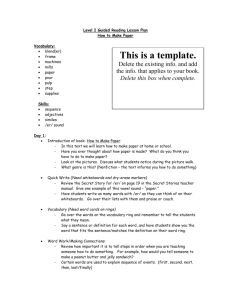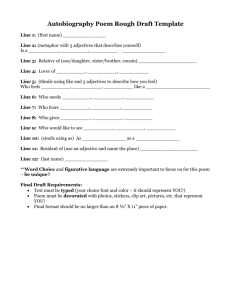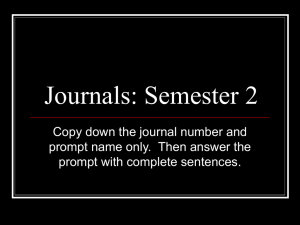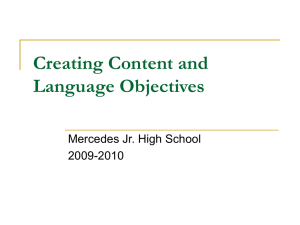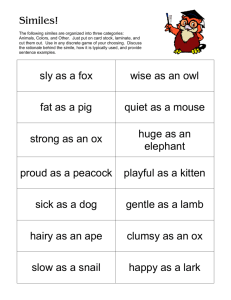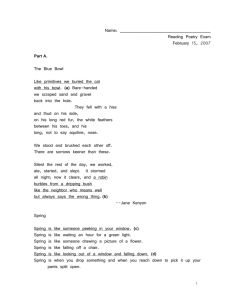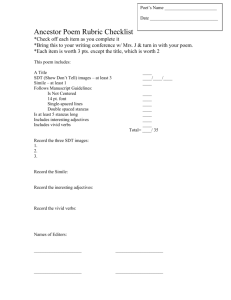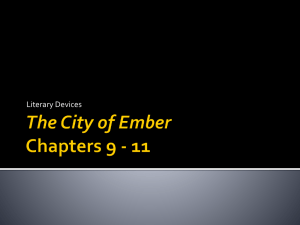File
advertisement
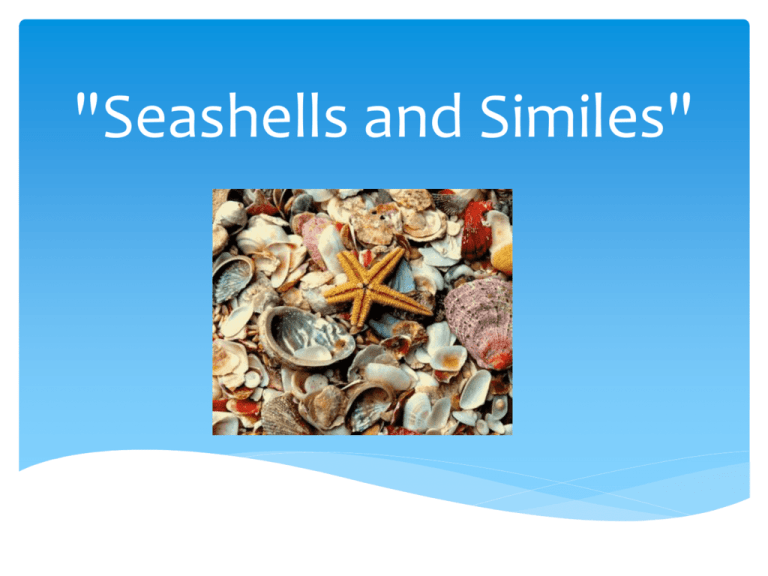
"Seashells and Similes" You will need to know similes to master state standards For example, your sixth grade standards state that you must: Determine the meaning of words and phrases as they are used in a text, including figurative language such as similes; Be able to apply similes in writing. Learning Similes Through Modeling The DEFINITION OF SIMILE: "Similes are used to encourage the reader to draw a comparison between two seemingly unrelated things, and find similarities between them, using the words "like or "as". Authors use similes to enrich their writing, to make their descriptions more vivid. His skin was She looked as as cold as ice. gentle as a It felt as hard lamb as rock To help you understand, you will play the "Connect" Game to develop the idea of comparing "two seemingly unrelated" ideas. Because the definition of simile might be too abstract, you will connect two different ideas, in a game like structure, trying to to find a connection, a similarity, that two random items share. 1. These popsicle sticks contain four different, random categories of words such as household items, emotions, animals, technology, etc. 2. You will pull two different categories and try to make a comparison. "Connecting" Two Unlike Items What if you pulled the words "exercise bike" and lion"? Can you connect how these might be similar? How is music like a taco? How is a football game like a computer? Listen for the similes in the following poem by Anne Lindberg, from the book, Gift of the Sea Background information on the author: Wife of Charles Lindberg who was the first man who crossed the Atlantic solo. She was an aviator in her own right, and won many awards for literature and aviation. Anne Lindberg's Gift of the Sea This is a snail shell, ROUND, FULL and GLOSSY as a horse chestnut. Comfortable and compact, it sits curled up LIKE a cat in the hollow of my hand. Milky and opaque, it has the pinkish bloom of the sky on a summer evening, ripening to rain. On its smooth symmetrical face is penciled with precision a perfect spiral, winding inward to the pinpoint center of the shell, the tiny dark core of the apex, LIKE the pupil of the eye. It stares at me, this mysterious single eye-- and I stare back. Now it is LIKE the moon, solitary in the sky, full and round, replete with power. Now it is like an island, set in everwidening circles of waves, alone, selfcontained, serene. What objects did she compare to her seashell? Chestnut Cat Eye Moon Island Using Anne Morrow Lindbergh’s patterns, compare your sea shell with as many thingssights, sounds, tastes, textures, and smells--as you can imagine. To help you see similarities, hold your seashell in three different positions. Then draw your sea shell from those three different PERSPECTIVES. In each perspective, brainstorm what that new shape looks like. What does each one of these perspectives look LIKE? There are no "wrong" answers A space ship? A top of a temple? A crab? An ice cream cone? A vase? A spider? Now translate your ideas into the following poetry "frame". .First Draft As I gaze into the___________________ of the shell. First it is like a (add when, where, adjectives and “ing” phrases for detail) _____________________________________________ And then it is like (add when, where, adjectives and “ing” phrases for detail) _____________________________________________ And then it is like (add when, where, adjectives and “ing” phrases for detail) _____________________________________________________________ And then it becomes (add when, where, adjectives and “ing” phrases for detail) ___________________________________________________ And now it is (add when, where, and adjectives for detail) _____________________________________________ And now it is like (add when, where, and adjectives for detail) _____________________________________________ And now I am ________________________________ Introduction to Metaphor Metaphor is the same as a simile WITHOUT "like or as. Share your poem with your neighbor and read it with the word "LIKE" and "AS". Now, read it a second time without the word "LIKE or AS". Congratulations, you just created a metaphor!!. REVISION: FINAL DRAFT Homework: Chose either similes and/or metaphors to revise your poem. Look again at Ms. Lindberg's poem and note her placement of adjectives. Option: Attempt to model how she moves adjectives all around. Her adjectives are out of order--in the beginning and middle of sentences.
